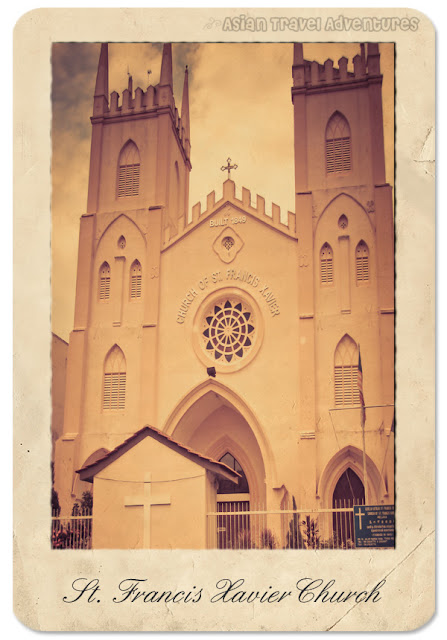Melaka is everything I imagined it to be: steeped in history, vibrant, and beautiful. It truly deserves its inclusion in the UNESCO's World Heritage List. History tells us the Straight of Malacca was a gateway for trade and commerce during colonial times. With this, Malacca became a target of conquests and was colonized by the Portuguese, the Dutch and the British. Their presence shaped what is now known as Melaka, which assimilated with the local, as well as the Peranakan culture. And this East-meets-West influence is evident in Melaka's architecture and edifices.
A day trip to Melaka from Singapore or Kuala Lumpur is ample but an overnight stay is encouraged. Although it is easy to navigate the streets, and one could round up most attractions in an afternoon, still, staying at one of the Peranakan heritage mansions-turned-inns/hotels in Melaka should not be missed. It'll give you a glimpse of the past and a chance to immerse yourself with Peranakan culture, at least on the superficial level. Aesthetically, these Peranakan hotels will most likely not disappoint.
Anyway, once we settled into our hotel, the Courtyard @ Hereen, we immediately got out into the streets in search for an ATM machine to withdraw some badly needed Malaysia currency. Apparently, the nearest ATM is quite a walk away; at least 10 to 15 minutes on foot, past the "Welcome to Melaka" sign. But it was the best place to start our walking DIY tour of Melaka.
It was a Sunday so there were too many vehicles and the traffic was end-to-end. Our first destination was just a few steps from the bank were we withdrew our money, the Church of Saint Francis Xavier.
This church is neo-gothic, with two tower spires. It reminds me a little of Manila's famous gothic church, the Basilica of San Sebastian. However, unlike the San Sebastian towers which has huge conical spires with little spires on the sides, there are only small conical spires at the topmost part of the towers of St. Francis Church.
There is also another interesting fact about the St. Francis Church. It seems to be leaning that no matter how hard I try to photograph it, it always look slanted.
See, it's a bit slanted.
Just across the church is the "Welcome to Melaka" sign, the start of the red-hued buildings (light maroon of some sorts).
We walked along the red corridor as shown above, since it was in the middle of the afternoon and therefore, hot, but it didn't take us long to reach the Dutch Square.
If you don't like the color red, then you will have to set aside your color abomination and pretend that everything you see is not your least favorite color. The red tones will be repeated throughout, up to the Stadthuys. So, better buck up.
The first of the red-hued buildings at the Dutch Square is the Youth Museum. We didn't enter the museum. I was not up for it, but I took photos of it outside.
Up next is the Melaka Art Gallery which is on the same building as the Youth Museum; only this one is facing the Queen Victoria fountain.
Beside the Art Gallery is the Christ Church of Melaka. Unlike the Church of St. Francis Xavier which is Catholic, the Christ Church is Protestant (Anglican), and is red all-over outside. Apparently, this was built in the 18th century, in 1753 as inscribed, by no less than the Dutch based on, well, Dutch architecture.
The Queen Victoria fountain lies in front of the Christ Church. It was so, so good to sit around the fountain as it gave a quick cool-down; a relief from the humidity. Many kids were playing in the fountain and I wanted to dip my feet in the cool waters, too. Anyway, while the fountain is located in the Dutch Square, or Red Square, this one is Dutch. Rather, it was built in commemoration of the Queen Victoria's diamond jubilee ascension to the British throne.
See the Dutch windmill in the background?
Anyway, this kid seems to want to take a dip.
The tip of the fountain is so ornate and pretty!
Of course, the Clock Tower is essential in this square so everyone will always know the time. Yup, four clock-faces on all four sides.
Just beside the Christ Church is another red-hued building, the famed Stadthuys. As difficult to decipher its pronunciation, this building is imposing in itself with intimidating red walls and glaring white windows. It is easier to refer to it as the Dutch town hall where the Dutch Governor and Deputy Governor once resided than to say its Dutch name.
Stadthuys is now a museum which charges a minimal fee. We didn't go inside. To reach the museum, just climb uphill and you will get a better view of the square and its surrounding areas.
While the Dutch Square is packed with attractions and souvenir stalls and colorful-but-bordering-on -being-garishly-decorated rickshaws or pedicabs, it is considerably small. Like this small.
Over-all, the Dutch Square is littered with tourists, vendors and rickshaws on weekends but it remains impressive. It is still a must see.

















No comments:
Post a Comment